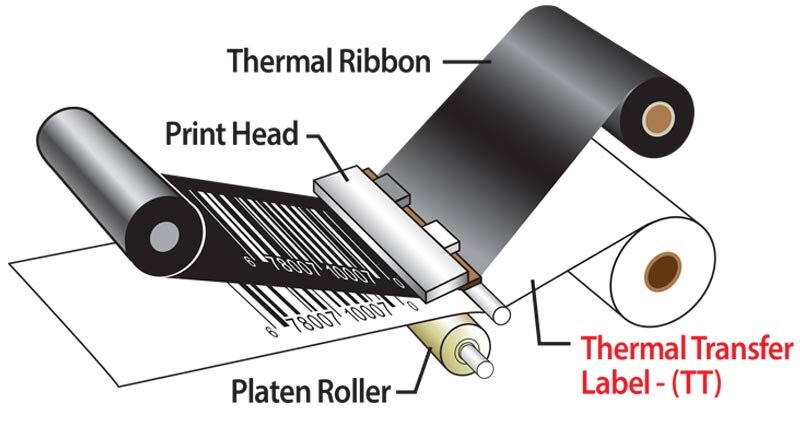Thermal Transfer vs Laser for Label Printing
Which printing process is better for labels, laser or thermal.
We tend to look at technology as one device that keeps getting bigger, faster and better. This may be true with computers and smart phones, but the reason so many different printing technologies exists is because we print on many different things, not just paper.
Chester Carslon inventor of Xerography
The dry printing process, later called Xerography, was invented by Chester Carlson. His job at the patent office in New York required him to make many copies of important papers. Frustrated by the difficulty and expense of copying documents, motivated him to conduct experiments with photoconductivity. This process eventually evolved from electronic/laser technology that made copies or originals “off the glass” to computers that interface to print directly to the laser printer.
Laser Printing
White bond paper was always the medium to be printed on as the laser printing technique progressed. The advent of new substrates, such as glossy papers and pre-cut labels on the flat sheets, was an effort to expand their offering.
Laser Label Quality and Durability
In Laser printing, positively charged carbon toner powder is released to the print drum and transferred to the paper. Heated rollers called the fuser melts the toner onto the paper. The resolutions of laser printing range from 600 dpi to 1200 dpi and will reproduce sharp and scannable barcodes. The longevity of laser printed labels is similar to thermal printing, however the wax-ribbon used in Thermal printing is naturally water-resistant compared to carbon base toner.
Cost of Laser Production
Assessing total costs of Laser label production needs to include, price of the printer, maintenance, label, and toner material costs.
Black and white Laser printers can range from $350 to $10,000.
Laser printers range from consumer/disposable to business class with repair contracts.
Toner cartridges are disposable and can be expensive. Average “click cost” on business printers is $0.6 cents.
The average cost of paper or synthetic label material is approximately 3x that of its competing thermal roll label. Sheet labels can be frustrating to print because there may multiple labels per sheet. If you only need 3 labels, labels waste occurs.
Thermal Transfer Printing
Thermal Transfer Printing Process
The first thing to understand about thermal label printing is that it was designed to print barcodes on labels and tags, hence the name. These labels are used not only for shipping but many, many more applications. The labels are manufactured on rolls or fan-folded to allow for a fast printing process. Note: The readability of barcodes is critical and the thermal print heads are designed to do just that.
Label Types : Determining the material cost of labels depends on whether you are using Direct Thermal Labels (no ribbon) or Thermal Labels (ribbon required). Very short term shipping labels often Direct Thermal the blank labels have a thermal coating embedded into the face that turns black when activated by the heated thermal print head. Lifespan of this label is about one week and provides minimal resistance from the rain. Thermal Transfer labels require a very thin roll of wax-resin ribbon, that is heated onto the label material, by the print head. This process, along with material type, can increase the durability and lifespan of the label by years.
Thermal Label Quality and Durability
Whether the thermal printer is a desktop or industrial model, they all do the same thing; heat electronic diodes on a print head which touches a label, creating a sharp black image. The print head diodes are measured in dots per inch (dpi). Print heads range from 203 dpi to 300 dpi, and 600 dpi for razor-sharp very small barcodes and text. Extremely durable label materials that are synthetic provide a very large range of rip and tear resistance as well as image quality that lasts years. Paper base labels are meant to have shorter a shorter shelf life and less durability, but can be pre-printed and coated to add increased protection.
Cost of Thermal Production
Assessing total costs of Thermal label production needs to include, price of the printer, maintenance, label, and wax ribbon material costs.
Thermal printers can range from $200 to $6,000 for extra wide industrial models.
Thermal printers generally require no maintenance for years. They do however, require print head cleaning with isopropyl alcohol after ever ribbon roll used.
Thermal labels come on rolls with small to large core sizes, depending on your printer. In general, larger rolls are less expensive than smaller rolls. There average 4”x6” paper shipping label, using a thermal ribbon, will cost $1.5 cents each. Note: Direct Thermal labels are the same price as Thermal Labels including the wax ribbon cost.
Thermal Ribbons come in Wax, Wax-Resin and Resin. The more resin in each ribbon the more expensive, although one does not produce better results; that is an action of the print head dpi. The label material type you print will require a certain ribbon type. Contact Barcode factory for specifics.
Conclusion
Laser printers are designed for paper laser sheets - not labels. Laser labels are less durable, 4 X or more the cost of thermal labels and print exceedingly slow compared to the slowest thermal printers today. If you’re printing labels, use a Label Printer. Even if your label usage is very low and you already own a copier, the savings on the labels will more than cover the cost of a desk top thermal printer, like a Zebra ZD410, the Citizen CL-E300 or the Intermec PC Series. These are all reliable low cost printers that work well with all popular software programs.




